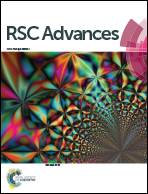Gold nanorod encapsulated bubbles†
Abstract
A simple method has been described for synthesizing gold nanorods (GNRs) encapsulated bubbles in a controlled manner. The method involves the use of nitrogen gas in the seed-mediated synthesis method routinely used for synthesis of GNRs. Control over the morphology of the nanostructures was achieved by nitrogen gas flow. The synthesized structures were examined by UV-Vis Spectroscopy, Scanning Electron Microscopy (SEM) and Atomic Force Microscopy (AFM). New structures of this type could conceivably serve as plasmonic biosensors, nanodevices and photothermal theranostics with dual modality imaging functionality.


 Please wait while we load your content...
Please wait while we load your content...